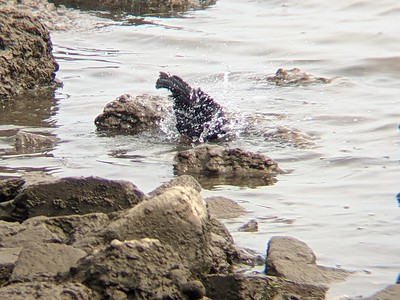
Greetings,
This month I only have three science articles but they're all good'uns.
If you know someone who wants to sign up to receive these summaries, they can do so at http://bit.ly/sciencejon (no need to email me).
PROTECTED AREAS:
Sullivan-Stack et al. 2022 is a great summary of marine protected areas (MPAs) in the U.S., and flags that achieving 30% U.S. ocean protection by 2030 is not on track to provide sufficient benefit to marine ecosystems. The key finding that stood out to me was the need for improving both geographic representation and efficacy / strength of protection (as well as climate resilience and equity). U.S. oceans are 26% protected overall (25% fully or highly protected), but 96% of that is in the central Pacific ocean. Excluding that region, only 2% has any protection (and only 22% of that 2% is fully or highly protected). See Table 3 for a summary of how much of each region is protected and at what level (Figure 1 has a map but it's not split by protection strength). Alaska has the lowest % protection of any kind (0.7%) while OR & WA have the weakest protection (4.2% of ocean is protected, but that's all minimal protection). Skip to section 4 for their recommendations: create more effective MPAs (via new ones and strengthening existing ones), improve representation of different marine regions & species & habitats in well-connected MPAs, improve equity & access, go beyond tracking % coverage and include impact assessments, make MPAs durable and climate resilient, coordinate state MPAs, reinstate and empower the MPA Federal Advisory Committee, strengthen & fund the NOAA MPA Center, and update the U.S. National Ocean Policy for holistic ocean planning and management.
ECOSYSTEM INDICATORS:
Nicholson et al. 2021 is chock full of useful diagrams and lists. They have a number of recommendations for setting ecosystem goals (which have milestones, targets, and indicators) for a global biodiversity framework, but which can be relevant to other efforts (like 30x30). At a high level they flag the need to track not only total ecosystem/habitat area (or extent), but also changes in ecosystem integrity (including the risk of ecosystem collapse - see Box 2 for definitions). Fig 2 is a nice visual summary of how different types of targets can collectively capture different threats and ecosystem attributes that need to be addressed for long term ecosystem health. Fig 3 is a super helpful review of many different environmental indices / metrics, and what aspects of ecosystems they include and omit. Spend some time with that one - even learning about all of the indices was very helpful for me. They close with 6 recommendations for picking indicators: we need a set of them (no single one suffices), they need to reflect goals (not actions), relevance to the goal is at least as important as data availability, we need more testing and validation of indicators, we need stronger connections between global indicators and national or local policies, and we need new indicators to provide early warning of ecosystem collapse.
ECOSYSTEM CONDITION:
There are good remote sensing data for land cover change, worse but decent data for land use change, but generally not much on degradation (which means we can underestimate ecological decline). Swaty et al. 2021 describe a "Vegetation Departure" (VDEP) spatial data set for the US which gets at this. This includes whether early or late successional stages are over-represented or under-represented (think of a logged forest w/ no old growth left but plenty of young forest, or a grassland being taken over by denser shrubs which were historically less common). They highlight several limitations of the existing LANDFIRE VDEP data (which focuses on canopy cover and height), and recommend that users consider other attributes that are important to their ecosystems of interest (e.g., biodiversity, wildlife populations, wildfire risk, etc.).
REFERENCES:
Nicholson, E., Watermeyer, K. E., Rowland, J. A., Sato, C. F., Stevenson, S. L., Andrade, A., Brooks, T. M., Burgess, N. D., Cheng, S.-T., Grantham, H. S., Hill, S. L., Keith, D. A., Maron, M., Metzke, D., Murray, N. J., Nelson, C. R., Obura, D., Plumptre, A., Skowno, A. L., & Watson, J. E. M. (2021). Scientific foundations for an ecosystem goal, milestones and indicators for the post-2020 global biodiversity framework. Nature Ecology & Evolution, 5(10), 1338–1349. https://doi.org/10.1038/s41559-021-01538-5
Sullivan-Stack, J., Aburto-Oropeza, O., Brooks, C. M., Cabral, R. B., Caselle, J. E., Chan, F., Duffy, J. E., Dunn, D. C., Friedlander, A. M., Fulton-Bennett, H. K., Gaines, S. D., Gerber, L. R., Hines, E., Leslie, H. M., Lester, S. E., MacCarthy, J. M. C., Maxwell, S. M., Mayorga, J., McCauley, D. J., … Grorud-Colvert, K. (2022). A Scientific Synthesis of Marine Protected Areas in the United States: Status and Recommendations. Frontiers in Marine Science, 9(May), 1–23. https://doi.org/10.3389/fmars.2022.849927
Swaty, R., Blankenship, K., Hall, K. R., Smith, J., Dettenmaier, M., & Hagen, S. (2021). Assessing Ecosystem Condition: Use and Customization of the Vegetation Departure Metric. Land, 11(1), 28. https://doi.org/10.3390/land11010028
Sincerely,
Jon
p.s. The photo above is of a red-winged blackbird bathing in the Potomac River at Dyke Marsh